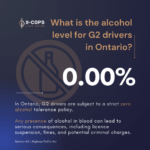
What Is the Difference Between G and G2 Licenses in Ontario?
In Ontario, the process of obtaining a driver’s license is divided into a two-step process known as the graduated licensing system. This system helps new drivers gradually gain experience and responsibility behind the wheel, starting with a G1 license and progressing through G2 before achieving full driving privileges with a G license. If you’re a new driver or you’re planning on getting your Ontario driver’s license soon, it’s important to understand the differences between the G and G2 licenses and how they impact your driving experience. In this article, we’ll break down the key differences between these two stages of Ontario’s licensing process.
What is a G2 License?
Limited Time Automotive Amazon DealsThe G2 license is the second stage in Ontario’s graduated licensing system. To obtain a G2 license, you must first hold a G1 license for a minimum of 12 months. However, you can reduce this waiting period to just 8 months if you complete a government-approved driver education course. Once you have met this requirement, you can take the G2 road test. The G2 road test is designed to assess your basic driving skills, including turning, stopping, parking, and general control of the vehicle.
With a G2 license, you’re granted more freedom compared to the G1 stage. While you can now drive without the supervision of a fully licensed driver, there are still some restrictions in place to ensure safety and help you gain more experience before you can drive unrestricted.
Key Restrictions for G2 Drivers
- Zero Blood Alcohol Concentration (BAC): One of the most important restrictions for G2 drivers is that you must have a zero BAC at all times while driving. This means that you cannot have any alcohol in your system when operating a vehicle.
- Passenger Restrictions for Young Drivers: If you’re under 19, there are limitations on the number of passengers you can carry in your vehicle between midnight and 5 a.m. During the first six months of holding your G2 license, you are allowed to carry only one passenger who is 19 years old or under during these hours. After the first six months, this limit increases to three passengers, as long as they are not immediate family members.
- Seatbelt Compliance: All passengers must wear seat belts, and the number of passengers cannot exceed the number of seat belts available in the vehicle.
Despite these restrictions, the G2 license is an important step toward becoming a fully licensed driver. It provides new drivers with the chance to gain more experience behind the wheel while still operating within a structured framework that emphasizes safety.
What is a G License?
The G license represents full, unrestricted driving privileges in Ontario. To qualify for a G license, you must have held your G2 license for at least 12 months and pass the G road test. The G road test is more comprehensive than the G2 test and focuses on assessing your ability to handle more complex driving situations, such as highway driving, parking in tight spots, and dealing with more challenging road conditions.
Limited Time Automotive Amazon DealsOnce you pass the G road test and obtain your G license, you no longer have to worry about the restrictions associated with the G2 license. This means no limitations on the number of passengers you can carry, and you can drive at any time of the day or night without restrictions. However, if you’re under the age of 21, you will still be required to maintain a zero BAC while driving.
Benefits of a G License
- No Passenger or Time Restrictions: With a G license, you can drive at any time and carry as many passengers as there are seat belts available in your vehicle. There’s no curfew, so you’re free to drive whenever you need to, without any restrictions.
- Increased Flexibility: As a full G license holder, you’re no longer restricted by the G2 limitations that may affect young drivers. For example, you no longer have to worry about the restrictions on driving with passengers after midnight, which can be a significant convenience for many drivers.
The G license is the ultimate goal for most drivers in Ontario. It provides full freedom on the road and removes many of the limitations that come with the G2 license. However, it’s important to keep in mind that, even with a full G license, drivers under the age of 21 are still subject to the zero BAC rule.
Key Differences Between G2 and G Licenses
Now that we understand what the G2 and G licenses entail, let’s look at the key differences between the two:
- Supervision:
- G2 License: G2 drivers can drive without the supervision of a fully licensed driver, but they are still subject to certain restrictions (such as passenger limits and zero BAC).
- G License: G license holders have no restrictions, and they can drive independently at any time with any number of passengers, as long as seatbelt laws are followed.
- Passenger and Time Restrictions:
- G2 License: G2 drivers, especially those aged 19 or under, have limits on the number of passengers they can carry between midnight and 5 a.m. These restrictions gradually ease after six months or when they turn 20.
- G License: No restrictions on the number of passengers or driving hours for G license holders.
- Blood Alcohol Concentration:
- G2 License: Drivers with a G2 license must maintain a zero BAC while driving.
- G License: While G license holders over 21 can have alcohol in their system (but still within the legal limit), those under 21 must maintain a zero BAC, similar to G2 drivers.
- Road Test Requirements:
- G2 License: The G2 road test evaluates basic driving skills like turning, parking, and controlling the vehicle.
- G License: The G road test evaluates advanced driving skills, including highway driving, merging, and handling complex road situations.
Conclusion
In Ontario, the G and G2 licenses represent two important stages in a new driver’s journey. The G2 license offers more freedom than the G1, allowing drivers to operate a vehicle independently but with certain restrictions. The G license, on the other hand, provides full driving privileges without the limitations that come with the G2.
Understanding the differences between these two licenses helps drivers make informed decisions and ensures they stay compliant with Ontario’s road safety laws. Whether you’re a new driver working toward your G license or a parent helping your teen navigate the process, knowing what to expect at each stage will make the transition to full driving privileges a smooth one.
Have questions about driving in Ontario or need more tips for new drivers?
Check out our latest posts at FlipCars.ca for more useful information on everything from car buying to driving in Ontario!
Add a comment Cancel reply
Categories
- Auto Detailing (1)
- Car News (2)
- Car Reviews (1)
- How To (1)
- Uncategorized (156)
Recent Posts
About us

Related posts


Ontario G2 License Restrictions 2026

Cost of a Hellcat in Canada: Charger, Challenger & Engine Prices Explained








